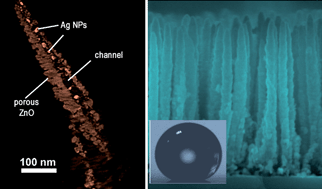M. Macías-Montero, A. Borrás, Z. Saghi, P. Romero-Gómez, J.R. Sánchez-Valencia, J.C. González, A. Barranco, P. Midgley, J. Cotrino, A.R. González-Elipe
Journal of Materials Chemistry, 22 (2012) 1341-1346
doi: 10.1039/C1JM13512K

In this article we present a new type of 1D nanostructures consisting of supported hollow ZnO nanorods (NRs) decorated with Ag nanoparticles (NPs). The 3D reconstruction by high-angle annular dark field scanning transmission electron microscopy (HAADF-STEM) electron tomography reveals that the Ag NPs are distributed along the hollow interior of the ZnO NRs. Supported and vertically aligned Ag-NPs@ZnO-NRs grow at low temperature (135 °C) by plasma enhanced chemical vapour deposition on heterostructured substrates fabricated by sputtered deposition of silver on flat surfaces of Si wafers, quartz slides or ITO. The growth mechanisms of these structures and their wetting behavior before and after visible light irradiation are critically discussed. The as prepared surfaces are superhydrophobic with water contact angles higher than 150°. These surfaces turn into superhydrophilic with water contact angles lower than 10° after prolonged irradiation under both visible and UV light. The evolution rate of the wetting angle and its dependence on the light characteristics are related to the nanostructure and the presence of silver embedded within the ZnO NRs.

